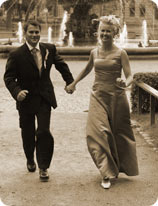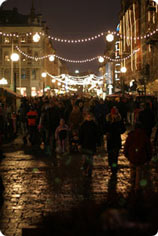History
 For
"viking"- and pre1621 historic Sundsvall
history please refer to the Sundsvall museum at
Kulturmagasinet. For this website 1621 is the
"kick off" for Sundsvall. For
"viking"- and pre1621 historic Sundsvall
history please refer to the Sundsvall museum at
Kulturmagasinet. For this website 1621 is the
"kick off" for Sundsvall.
1600s
The town was founded in 1621 by king Gustav
II Adolf, Sweden´s most succesful military
leader. At the time Sweden was a growing superpower
state and the plan was to give Sundsvall town
privileges to make the Baltic Sea region more
powerful.
The king strived to make Sweden more developed
and more like towns in continental Europe.
And for this purpose he needed cities as a symbol
for power and prosperity and cause towns and
cities generates taxes and incomes for the head
of state. The great plan of Gustav II Adolf
was to turn Sweden into a superpower state full
of cities. The same year as Sundsvall was founded,
Latvia was invaded.
The king made Sweden a great power, captured
huge territories in the Baltics, the east and
south as far as Poland. The king was eventually
killed by his Catholic enemies in the Lützen
battle in 1632.
The king´s descicion to give Sundsvall
town priviliges was not popular among the local
farmers. One of them, Peder Pedersson from Tuna,
complained loudly: -"Sundsvall stad skulle
hava varit i helvetet, när han blev bygder
emillan Hudiksvall och Härnösand,
samt ock att alla de där bo äro loppor,
prackare, skinnare och skaffare". It´s
very hard to translate this sentence but it
means something like: Sundsvall town should
go to hell. All people living there are scammers
and lice.
The town of Sundsvall was established by royal
decree in 1621. During the 1600s as a new great
power, Sweden was constantly at war and in need
of money and weapons. For this reason more than
thirty new towns were established in Sweden
and Finland. In addition to Sundsvall, the towns
of Umeå, Söderhamn, Kristinestad
and others came into existence during this period.
These new towns were encircled by customs' walls
with gates supervised by customs officers. All
commerce with the surrounding rural areas was
prohibited. Before being permitted to sell their
produce in a town the farmers were required
to pay a customs duty which served as a source
of revenue for the monarch.
1700s
 In
1721 Sweden was at war with Russia and Russian
troops reached Sundsvall. The town dwellers
fled inland and soldiers under the command of
Major Fiandt attempted to defend the town but
without success. (There is a memorial stone
located at Videsbron.) In
1721 Sweden was at war with Russia and Russian
troops reached Sundsvall. The town dwellers
fled inland and soldiers under the command of
Major Fiandt attempted to defend the town but
without success. (There is a memorial stone
located at Videsbron.)
All of Sundsvall, with the exception of the
church and bell tower, was burned to the ground
by the invaders. The residents of Sundsvall
now faced the task of building up the town for
the second time in its history.
1800s
During the 1800s Sweden was one of Europe´s
poorer economies with an economy entirely based
on agriculture. However it was Sweden´s
natural resources such as timber and iron ore,
that formed the basis of its new-found wealth.
At the late 1800s Sundsvall became the most
important town for trade in the region of Norrland.
With the growth of the timber industry in the
1850s-1860s, it became a real boomtown, with
a further rapid increase in population.
The harbour proved to be of great importance.
Sundsvall became the centre of Sweden's largest
timber production areas.The population increased
tenfold between 1800 and 1900. A lot of poor
people migrated to the town looking for work,
but the town also became home to some of Sweden's
wealthiest people at that time, having made
their fortunes in the sawmill industry. The
town became segregated. Working class suburbs,
which were mainly unplanned and unregulated,
grew up on the outskirts.
In 1879 the first major strike in Sweden among
workers took place here in Sundsvall (the Sundsvall
strike). You can see a Sundsvall strike monument
3 km South of town at the Oljehamnen (Oil harbour).
The reason for the strike was a decrease in
wages.
Much of Sundsvall was reduced to ashes in the
devastating fire in 1888. The "Stone city"
of Sundsvall earned its nickname after the disastrous
fire in June 1888 which wiped out the wooden
town. Architects from all over Europe were called
in to rebuild Sundsvall in grand style and in
stone over the next decade. "Thanks"
to the fire our town has fine examples of neo-Gothic,
neo-renaissance and neobaraoque architecture.
The fire left over 9000 people homeless but
miraculously the fire left only four people
dead. Apart from a few buildings like Hedbergska
skolan/The Hedbergska school, the current Nordea
banking complex and current Casino Cosmopol,
remained nothing but ashes in the centre. In
1888 the town of Sundsvall was one of the wealthiest
towns in Sweden thanks to the forest industry
and sawmills.
In 1895 Sundsvall exported 700 000 m3 wood,
an incredible 19% of the total Swedish export.
Sundsvall was one of the world's largest sawmill
districts. At its zenith during the 1890s the
district had over forty steam-driven saws.
The rebuilding of the town created a very different
kind of society. The town centre was rebuilt
with stone houses which were inhabited by the
wealthier people; this drove large groups out
of the inner town. The town became segregated
into two parts--one planned and one unplanned.
The present Storgatan follows the same route
as the original Stora gatan and has for centuries
served as the town's main road.
In September 1891 famous author August Strindberg
visited Sundsvall for a week. He visited the
restaurant Tivoli night after night for "recreational"
purposes.
1900s
In 1910 the first tram took off from the town
centre to the suburb of Kubikenborg.
Did you know: The Sundsvall wrestler Rudolf
"Preven" Svedberg won the gold medal
during the berlin Olympic games in 1936. As
a memorial an oak tree was brought from Germany
to be planted at the Idrottsparken football
arena. Unfortunately the tree had to be taken
away in the 80s.
In the 1960s and 1970s the Sundsvall population
"grew" a lot but that was only on
paper and for administrational purposes since
several municipalities were merged with Sundsvall.
2000s
Our main business products has always been related
to the forest industry. Timber, beam, planks
but also different forms of iron products. The
most prominent business areas today are cellulose/wood/timber,
IT and Telecom, banking.
Today the Sundsvall region, is the home to some
115,000 people, is the most densely populated
area of northern Sweden. It plays a prominent
role, not only in sports, industry and commerce,
but also in education, culture and the arts.
Population:
In 1621: About 35 (!)
In 1721: 500 (at the time of the Russian invasion
and destruction)
In 1810: 1 485
In 1850: 2 837
In 1885: 10 275
In 1910: 16 854
In 1930: 18 007
In 1940: 18 852
In 1950: 25 706
In 1960: 29 419
In 1965: 58 174. The areas of Alnö, Selånger,
Skön are included in the statistics.
In 1970: 64 920
In 1974: 92 483. The areas of Njurunda, Matfors,
Stöde and Liden are included in the statistics.
In 2004: 93 707
In 2005: 94 044
Sources:
 Barbro Björk, Sundsvalls museum.
Barbro Björk, Sundsvalls museum.
 Umeå
Universitet.
Umeå
Universitet.
 Sweden. Lonely
Planet
Sweden. Lonely
Planet
 Destination Kasino. Erika Moll
Destination Kasino. Erika Moll
 Sweden. Insight guides
Sweden. Insight guides
 Medelpadsrötter
Medelpadsrötter
Press and media: Contact
us if you need to purchase pictures from Sundsvall.
All text & images © sundsvalltown.se.
All rights reserved. No part of this site may
be reproduced without the permission of the
publisher and copyright owner.
Disclaimer: We've tried to make the information
on this web site as accurate as possible, but
it is provided 'as is' and we accept no responsibility
for any inconvenience sustained . If you have
found any erronous or misleading information,
contact us.
|
 For
"viking"- and pre1621 historic Sundsvall
history please refer to the Sundsvall museum at
Kulturmagasinet. For this website 1621 is the
"kick off" for Sundsvall.
For
"viking"- and pre1621 historic Sundsvall
history please refer to the Sundsvall museum at
Kulturmagasinet. For this website 1621 is the
"kick off" for Sundsvall.
 In
1721 Sweden was at war with Russia and Russian
troops reached Sundsvall. The town dwellers
fled inland and soldiers under the command of
Major Fiandt attempted to defend the town but
without success. (There is a memorial stone
located at Videsbron.)
In
1721 Sweden was at war with Russia and Russian
troops reached Sundsvall. The town dwellers
fled inland and soldiers under the command of
Major Fiandt attempted to defend the town but
without success. (There is a memorial stone
located at Videsbron.)